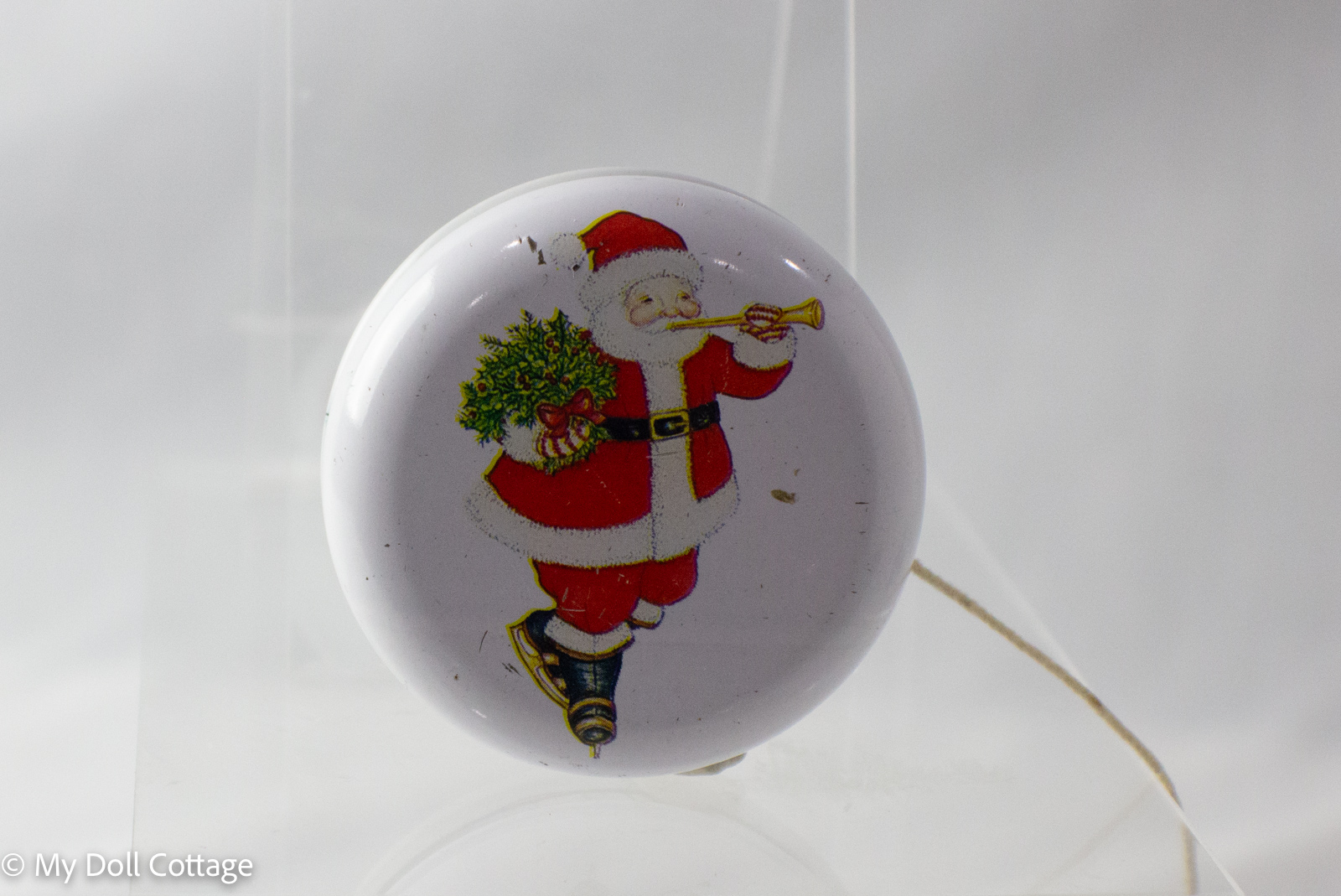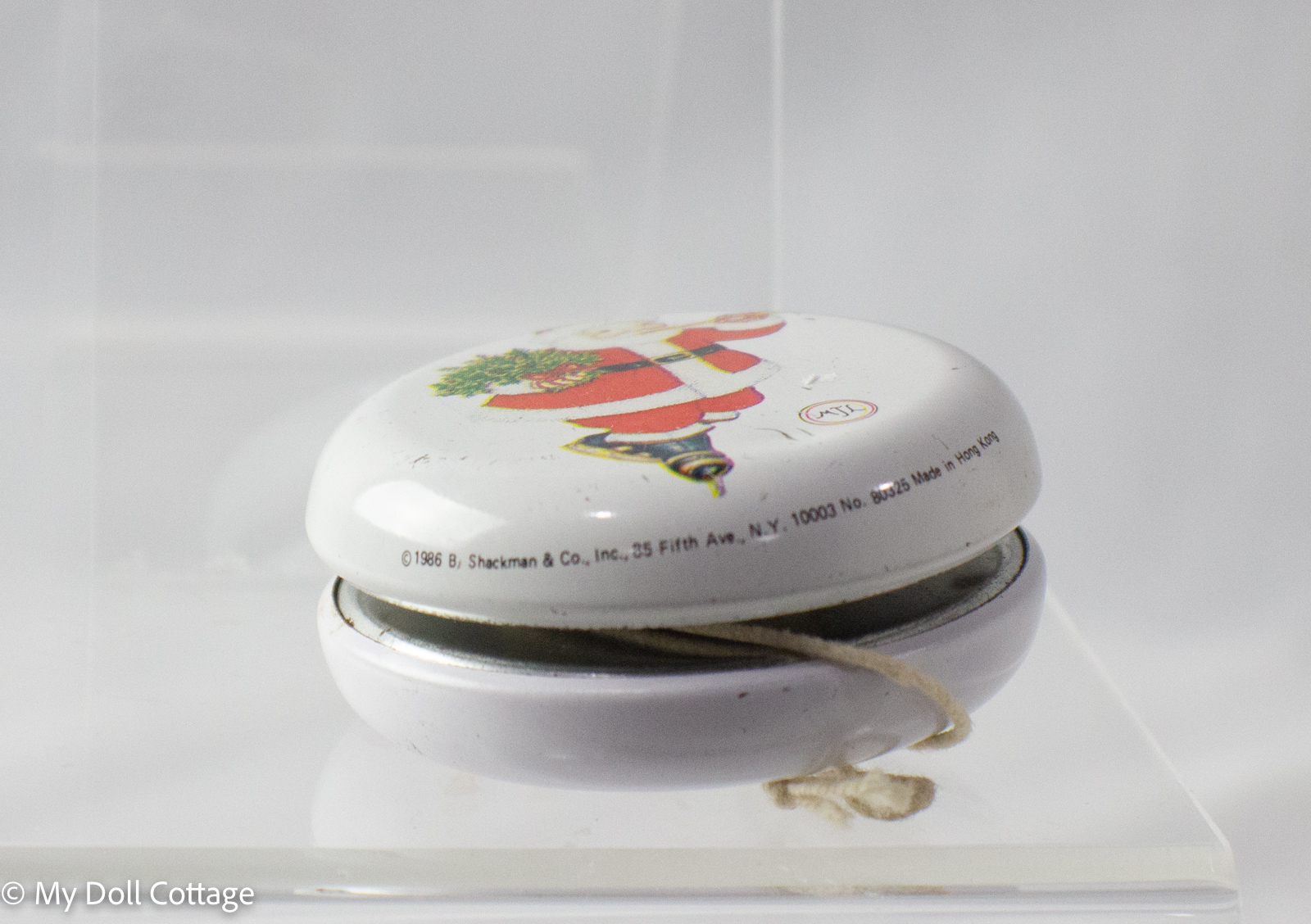1986 White Litho-Tin Santa Yoyo – B. Shackman & Co.

A 1986 lithographed white tin yoyo featuring Santa on skates blowing a horn, produced by B. Shackman & Co., made in Hong Kong, in good vintage condition with playable string.
This vintage yoyo measuresapproximately 55 mm in diameter and 35 mm deep, and is litho-printed onwhite tin featuring Santa in skates, holding a wreath and horn, with hollydetailing to the side.
The rim is marked “©1986 B. Shackman& Co., Inc., 85 Fifth Ave., N.Y. 10003 No. 80325 Made in Hong Kong.”The original string remains attached. It displays some small dents and surfacescratches, but remains fully usable as a yoyo—making it both a nostalgic toyand collectible decorative piece.
The Hong Kong manufacturing mark alignswith many 1980s novelty toys imported into the U.S., and listings show B.Shackman tin items from 1986 made in Hong Kong. Given its character, noveltymarket and condition, it’s a fine example of holiday-toy ephemera.
Features
Measurements: 55 mm roundx 35 mm wide
Condition: Good - smalldents and surface scratches
Markings: ©1986 B.Shackman & Co., Inc., 85 Fifth Ave., N.Y. 10003 No. 80325 Made in HongKong.”
Date Note: Date is an estimate based on available researchand stylistic features. If you have additional information, please contact usto help update our records.
Made from the following materials
Metal has played a significant role in the history of dolls and toys, with materials like cast iron, tin, and brass being used for centuries to create durable and appealing playthings. Each type of metal has distinct characteristics that have influenced its application in the toy industry, leading to a variety of designs and styles.
Cast Iron
Cast iron was one of the first metals used in toy manufacturing, particularly during the 19th century. Its strength and durability made it ideal for creating toys that could withstand the rigors of play. Cast iron toys were often made using molds, allowing for mass production and the creation of intricate designs. Popular cast iron toys included figurines, toy cars, and trains, many of which featured detailed craftsmanship and decorative paintwork. These toys were not only popular with children but also became collectible items over time, cherished for their historical significance and nostalgic appeal.
Tin
Tin, often used in the form of tinplate, became a favored material for toy manufacturing in the late 19th and early 20th centuries. Tin toys were lightweight, affordable, and could be produced in large quantities, making them accessible to a wide audience. Tinplate was often stamped or lithographed with colorful designs, bringing characters and scenes to life. Classic examples of tin toys include wind-up cars, robots, and playful animals, many of which featured moving parts that delighted children. Tin toys remain popular among collectors today, valued for their charm and the artistry involved in their design.
Brass
Brass, an alloy of copper and zinc, has been used in toy making for its attractive appearance and durability. It is particularly well-suited for creating smaller components, such as gears and mechanisms in wind-up toys. The shiny, golden hue of brass gives toys a sense of elegance and sophistication, often seen in decorative pieces and collectibles. While brass dolls are less common than those made from other materials, some artisans have crafted beautiful dolls with brass accents, adding a touch of luxury to their designs.
Throughout history, the use of metal in dolls and toys has allowed for a diverse range of creations, each reflecting the technological advancements and artistic trends of their time. The durability of metal ensures that many of these toys have stood the test of time, allowing them to be enjoyed by new generations of children and collectors alike.
At our museum, we celebrate the legacy of metal dolls and toys, highlighting their role in the evolution of play and the craftsmanship that goes into creating these timeless treasures. From the strength of cast iron to the whimsical designs of tin and the elegance of brass, these materials tell a rich story of creativity and innovation in the world of toys.
Cloth dolls and toys have a rich history, rooted in the traditions of various cultures around the world. Made primarily from fabric, these dolls are characterized by their soft textures, vibrant colors, and the use of various sewing techniques. The creation of cloth dolls dates back centuries, often reflecting the cultural heritage and artistic expressions of the communities that produce them.
Historically, cloth dolls were often handmade by mothers and grandmothers as toys for children, using scraps of fabric and other materials available in the household. These dolls were not only sources of comfort and play but also served as tools for teaching children about sewing and crafting. The diversity of fabrics used—ranging from cotton and wool to silk and felt—allowed for endless creativity in design, giving rise to a multitude of styles and forms.
Cloth dolls often embody the characteristics of the culture from which they originate. For instance, traditional rag dolls from the United States were typically made from leftover fabric and filled with scraps, while Japanese Kokeshi dolls are simple wooden dolls often painted with floral designs. In many cultures, cloth dolls have also served ceremonial purposes, being used in rituals or as representations of important figures.
In the modern era, cloth dolls have seen a resurgence in popularity, particularly among those who appreciate handmade and artisanal items. Contemporary artisans create unique cloth dolls that often incorporate modern design elements while honoring traditional techniques. These dolls may feature intricate stitching, detailed facial expressions, and a variety of clothing styles, making them appealing to collectors and children alike.
Today, cloth dolls and toys continue to be cherished for their tactile quality and the personal touch that comes from being handmade. Their ability to convey warmth, creativity, and cultural significance makes them timeless treasures in the world of toys, offering both play and connection to the rich history of doll making.
Composition
Composition dolls and toys represent a unique chapter in the history of doll-making, particularly prominent from the early 20th century until the mid-20th century. These dolls are crafted from a mixture of materials, primarily wood pulp, sawdust, and other additives, which are then pressed and molded into shapes. This innovative process allowed for the mass production of dolls and toys that were more affordable and durable than their porcelain or clay counterparts.
The composition material was designed to mimic the look and feel of more expensive materials while being lighter and less fragile. These dolls often featured painted facial details, painted hair, and fabric bodies, making them accessible to a broader audience. Because of their affordability, composition dolls became extremely popular during the Great Depression, as families sought quality toys at reasonable prices.
Dolls made from composition often reflect the styles and fashions of the eras in which they were created. Many classic designs include baby dolls with chubby cheeks, elegant fashion dolls, and character dolls based on popular culture. The versatility of composition allowed for a wide range of expressions and poses, making these dolls appealing to children and collectors alike.
However, as synthetic materials and plastics emerged in the mid-20th century, the popularity of composition dolls began to decline. Over time, the composition material was found to be less durable than other options, leading to issues like chipping and cracking, especially when exposed to moisture. Today, many collectors seek out vintage composition dolls for their historical significance and the nostalgia they evoke.
Composition dolls and toys remain an important part of the history of doll making, showcasing the evolution of materials and techniques used to create cherished playthings. At our museum, we celebrate these dolls not only for their craftsmanship but also for the stories they tell about the times and cultures in which they were made.
Related Dolls and Toys from our collection






